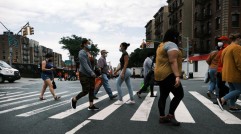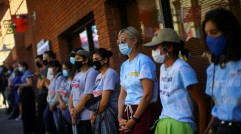'The Pearl Button' Director Patricio Guzman Recalls Adventurous Journey to Complete Film [EXCLUSIVE]
In February, Patricio Guzman introduced his new documentary, "The Pearl Button," to the Berlin Film Festival where it scored rave reviews and won the best Screenplay award. The film went on to play in various festivals and garnered a lot of awards buzz.
Guzman is best known for his work on "Nostalgia for the Light," "Mon Jules Verne," "Salvador Allende" and "The Pinochet case."
His new film "The Pearl Button" delves into the history of Chile and goes to the depths of its culture in the south. Guzman spoke to Latin Post about his research process and his discoveries while making the documentary.
Latin Post: What was the inspiration for this movie?
Patricio Guzman: When I was shooting my previous film "Nostalgia for the Light," I had the impression that a similar thing could happen in the south with the natives, which were exterminated at the beginning of the 20th century.
After being in Paris, I went to the sound with my assistant director and a sound recordist, with whom I usually work, and we went on a boat, and we went through the south. We went to a number of places where the natives had lived, and I read about indigenous who come from a number of different tribes. They lived between the island of Chiloe and Gulf of Angamos.
They were few people, and I thought this was an extraordinary subject because when I got to Europe I started to look for the iconography. I found that the indigenous were photographed by an Austrian priest who was educated in Germany and who went to the missions in 1910 to Chile in the south. I realized that with these photos that it was an extraordinary place to begin. Out of the 1000 people who used to live there only seven were left.
When I was in Santiago, Chile, I discovered a button that was attached to a metal track that was used to throw people into the ocean. It was a coincidence that the first native from the south that accepted to go to Europe decided to do it in exchange for a button. So I combined the two stories and that is how I began to work on this film.
LP: At what point did you communicate with the indigenous people that are in the movie?
PG: I called Gabriela, one of the indigenous, through her son, and she came from her city to Punta Arenas, and I was able to interview her. She is the most intelligent woman that comes from her heritage, and she is so descriptive of the life they used to have.
She is 75 years old and is very imaginative and clear. She is conscious of her heritage, and she considers herself Kaweskar and Chilean.
The others I found in another village, south of Punta Arena where many descendants of indigenous people live. I found the other woman and the man, who is a relative. They are pure indigenous, but they are grateful for living in Chile. However, they still maintain their heritage.
LP: How long was the research process? And what new information did you learn from it?
PG: I spent a year researching and in that year I wrote a script that was approximate to what I wanted to do. However, it was not exact because it is hard to make an exact script for a documentary. However, it is easy to write what you want for your film. After going to locations I wrote another script that was more exact, and with that script we began to take it to TV stations.
From there I located the archaeologist, the historian and the poet. With these three people and the indigenous, I was more assured of making the film.
LP: There are a lot of pictures of the tribes. What was the process of obtaining these pictures?
PG: They are in an institute in Bonn, Germany called the Anthropos Institute of San Augustine. There is a big archive of the pictures the priests took, and this institute gave me 1,000 pictures. The director of the institute helped me after I showed him my script and he was happy to help.
Other pictures came from Chilean archives from other explorers who were there. Italian explorer, Agostini, an alpinist and priest also took some pictures while he was exploring the south.
LP: There is a Chilean map made for the film. Can you tell me the process of making it, and what was the idea behind it?
PG: The painter's name is Emma Mani, and I already worked with her in my previous film "The Pinochet Case." On that film, Emma made another map that imagined where the exiled Chileans were. It was an enormous map that was the size a wall. That map was made for the museum of Bellas Artes of Chile, and there I interviewed her because I wanted to know why she made those maps and the purpose of them.
Since she lived in Paris, I went to her and asked her for a map of Chile that would be about 15 meters long. She was happy and made it on cardboard paper. I wanted her to show the length of Chile, which is 4000 kilometers. She made the map and shows it in front of the camera.
The purpose is to show the immensity of Chile as it is a strange country because there is no racial unity nor cultural unity. The people from the south are very different from the people from the south. I wanted to show the immensity of the land, which ends with a number of canals which fractures the line.
LP: The film shows the concentration camps that were used during the time of Pinochet. Were you guys able to visit them?
PG: In the south the concentration camp is in the same place where original mission took place. It is on an island that is in front or Punta Arenas, and on this Island the priests made a colony for the natives and kept them there for 50 years. Most of the natives died because when they dressed the natives coming from Europe, the clothes were contaminated. Since the island was owned by the military, when Allende's government was overthrown, they took his followers to these camps. They put about 60 people there as well as 1,000 prisoners of war. But they separated the former ministers and the prisoners of war. They were there for a year and half. Some died while others went back home.
LP: Where did you go to get the images of the glaciers and the mountains?
PG: We rented a boat of about 12 meters and we had two captains. We rented it for 12 days, and we went through the Beagle Canal. We went both directions to get images of the volcanoes and images of the Patagonia as well as the glaciers. Everything that appears in the movie is original footage.
LP: At the beginning of the film you talk about your fears with the Pacific Ocean. After finishing the movie did these fears go away or how did your relationship with the ocean change?
PG: No, my fears did not go away. The Pacific Ocean is tremendous especially in Chile. There are places to actually swim in it, but it's an ocean that is so huge. You know that it is an ocean that goes all the way to Australia, and that makes it even more terrifying.
LP: What compels you to narrate your films?
PG: I like to narrate my movies. I began doing it when I did a documentary about Julio Verne, and it's been 12 years since I narrated. I thinks there's greater verisimilitude in telling a story yourself that you are creating.
LP: When the movie made its world premiere in Berlin, the film went on to win various awards. Were you expecting such a response?
PG: No, because it was a festival that is dominated by fiction. When I did "Nostalgia of Light," I knew we were going to win awards at documentary film festivals but not at this festival. The director of the festival this year was very receptive to accept documentaries into the competition.
LP: How has Chile reacted to the film?
PG: It has not come out, but I have some good criticism. We have to wait, and I think it will get good reactions. However, in Chile there are 70 theaters that show North American films and some European films. Pablo Larrain and I have similar audiences, and we don't get many theaters to show the film. As a matter of fact after two weeks the movie disappears. There are not enough independent screens and one of the things that Chilean filmmakers are doing to create chain of independent theaters, and it is something that we hope to pull off.
LP: What do you hope audiences take away from it when they see it?
PG: I think the movie will allow the USA to see what happened in Chile with indigenous natives and the political prisoners. I also think it will create admiration for the imagery and beautiful nature in the south of Chile. I also think it's filled with human reflection, philosophical and metaphysical reflections of space and the earth's destiny. I think it has many metaphors that are applied to many regions of the world as well, and I think that will be interesting to see.
Subscribe to Latin Post!
Sign up for our free newsletter for the Latest coverage!












